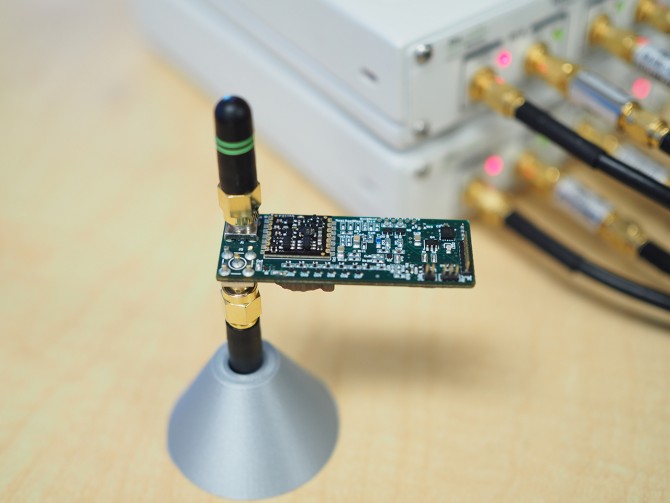Tech used to thwart shoplifters could help keep buildings safe
By Matt Hayes
Did something move just a hair? Cornell engineers have developed a simple and reliable way to measure it.
Researchers have created a radio frequency identification (RFID) system capable of taking high-frequency measurements as small as 50 microns, about two-thirds the width of a human hair. In water, high-frequency 5-micron measurements can be achieved. The resolution is 200 times more accurate than UHF radio measuring capabilities, opening potential applications spanning from safety systems that monitor the structural integrity of buildings and bridges to robotic feedback controls that allow unprecedented fine-motor precision.
“UHF radio measuring methods right now are limited to resolutions of about a centimeter or more, which is hopeless for advanced technological needs like touch robotics,” said Edwin Kan, professor of electrical and computer engineering. “Our method provides resolution accuracy beyond previous belief.”
Kan is the senior author on the paper, “Radio Ranging With Ultra-High Resolution Using a Harmonic Radio-Frequency Identification System,” published March 15 in Nature Electronics. Doctoral student, Xiaonan Hui, is the lead author.
UHF RFID technology is already commonly deployed in commercial settings. RFID tags are used in everything from monitoring merchandise in stores to maintaining bike-sharing programs. But until now the technology has faced ranging limitations that hamper usefulness and reliability at small scales.
Previous strategies aimed at measuring more precise distances have centered on using signals at ever higher frequencies. But extremely high frequencies, such as collision-avoidance radar systems above 60 GHz, are not ideal for indoor environments or building structures where signals get blocked by many surfaces.
The Cornell engineers solved the problem using a harmonic system that sends a signal around 1 gigahertz – a harmless frequency already used in many household devices. The passive sensor tag, which does not require power and can be embedded in structures as a marker, then echoes the signal at double the frequency, eliminating interference and noise issues that plague conventional RFID systems.
Operating at the UHF band of 300 megahertz to 3 gigahertz, the system works in indoor settings where signals can harmlessly penetrate walls, construction material, living tissue and even water.
Kan said the technology could be used to protect lives by monitoring the structural integrity of buildings; it also could be deployed in everyday items inside the home for security monitoring or other purposes.
“Our method can reach resolution and accuracy that’s far superior to many other approaches with comparable cost,” said Hui. “The sensors work on objects of all sizes and pinpoint their locations in space. As more everyday items become linked and networked across the ‘internet of things,’ precision localization becomes crucial. This method opens up that reality.”
The new system, according to the researchers, could vastly improve how robots sense and touch objects. The improved localization would allow a robot to more accurately measure its environment and the exact location of its own appendages.
Currently, robots often appear clumsy when interacting with objects because locating technology only allows spatial resolution of a centimeter or more. Robots that rely on optical vision are limited in the same way humans are: visible light doesn’t penetrate many surfaces. And visible light doesn’t naturally give unique tagging in ways that RFID delivers.
“Localization methods used today are quite limited,” said Hui. “If you want to measure something with useful high precision, it was very expensive. We finally changed that.”
The study was funded by the U.S. Department of Energy.
Media Contact
Get Cornell news delivered right to your inbox.
Subscribe

